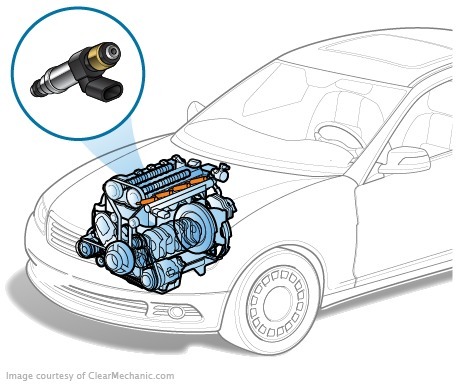
The fuel injector (which is often referred to as the injector of the English name injector) is intended for the dosing of the engine. In our time, the fuel injectable has become an indispensable attribute of the injection system not only of petrol, but also diesel engines. History of fuel force generation
History of fuel force generation
In the late 1960's, the problem of air pollution by car exhaust was acute. At that time, in order to achieve as much engine power as possible and to maximize the use of the air in the combustion process, the typical plant configuration of the carburetor was the intentional re-enrichment of the mixture.
The use of injectors in the injection system is due to the fuel crisis of the 1970s and to the close attention to the protection of the environment in the 1980s
The car acquired the necessary "care", but this affected the cost and excessive consumption of combustion products, including those harmful to the exhaust. It became clear that the design of fuel equipment needed to be drastically changed to reduce harmful emissions. The solution was to first create a single fuel injecboard and then a distributed fuel injection system.
The first such systems appeared in the 1930s and were used in aircraft engines. They were then used on racing cars, and in 1954, Mercedes-Benz presented to the world public the first serial production vehicle with a mechanical fuel injection system developed by Bocsh. In 1957, several models of Pontiac and Chevrolet set up a Rochester injection system, which proved to be quite complex and unreliable.
It is a thin and precision mechanism with a high price. For example, the cost of a diesel BMW X5 is around 17,000 rubles
In 1967, the first e-control injection system was established. In this system, the electric pump was supplied by a constant pressure of 0.2 MPa to the electromagnetic fuel injectors at regular intervals, at the same time as the injection pump inlet. In 1973, a system was created in which fuel was supplied by an electric pump to the fuel injector, which continuously sprayed fuel into the pipeline. In the same year, an electronic system with electromagnetic fuel injections was created, driven by electronics based on airflow measurements. It was the first smart injection.
Fuel injecpart machine and operating principle
Depending on the method of fuel injection, three types of injectors are electro-hydraulic, electromagnetic and piezoelectric.

Hydraulic fuel injective
The electro-hydraulic nozzle is often used in diesel injection systems. The structure consists of a control room, an electromagnetic valve, a intake and discharge pipe. The principle of operation is based on fuel pressure, not only on injection, but also on its termination. In the initial position, the electromagnetic valve is closed and de-energised, the fuel injectable needle is pressed (by the fuel pressure on the piston in the control room) to the saddle. Accordingly, no injection occurs. The pressure of the fuel on the needle is less pressure on the piston (due to the difference of the contact area). The electronic control unit activates the electromagnetic valve that opens the mucus. Through this throttle, the fuel from the control room goes into the drain. The intake throttle is an obstacle to the rapid equalization of pressure at the inlet line and control compartment. The pressure on the piston is decreasing and the fuel pressure on the needle remains the same, the needle rises and injects the fuel.
The accuracy of the fuel dosing can be judged by the rate of discharge of the nozzle. During the injection, the valve opens only 1-2 milliseconds
Electromagnetic trout
The electromagnetic force is used mainly on petrol engines. It includes a nozzle and an electromagnetic valve with a needle. Due to the algorithm, the control unit at the right moment provides the voltage to wrap the excitation of the electromagnetic valve. An electromagnetic field is created, breaking the force of spring, retractor with a needle and releasing nozzle. There's fuel injection. As soon as the tension disappears, the spring returns the needle back into the saddle.
Pioelectric trout
The piezoelectric nozzle is the most perfect fuel injection device to date. It is generally installed on diesel engines. It consists of a pushrod, a piezoelement, a needle and a switching valve. There is a hydraulic principle used in this form. The first position of the needle was put on the saddle due to high fuel pressure. As soon as the electrical signal is sent to the piezine, the length of the signal is increased, thereby transferring the force to the push-rod piston. The switch opens and the fuel falls into the drain. Above the needle the pressure falls, the pressure in the lower part of the needle rises and the fuel injection takes place.
Advantage and disadvantages of fuel injectors
Fuel injector systems that use fuel injector have the following advantages in front of the carburette systems: more economical fuel consumption by accurate dosing; minimization of exhaust gas toxicity; 7-10% increase in powertrain capacity; ease of launch regardless of weather; improvement of dynamical properties of the machine; no cleaning and replacement is required. However, fuel injectable systems also have disadvantages: first of all, high fuel quality requirements. The chemical composition of fuel, water and mud, which are often found in diesel fuel, are damaging to the thin mechanism of the nozzle. The cost of replacement and repair is another lack of distributed injection systems.







